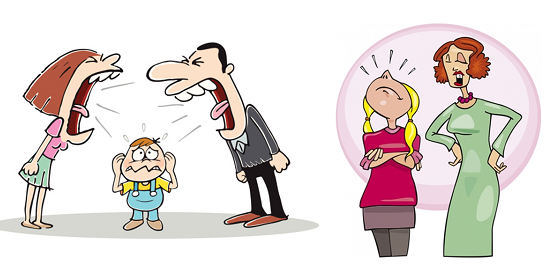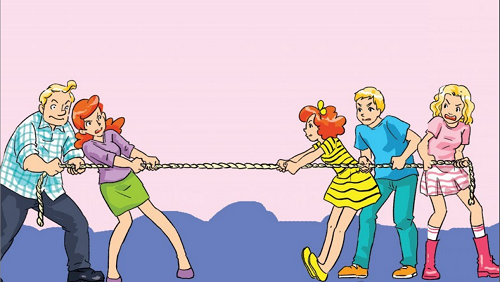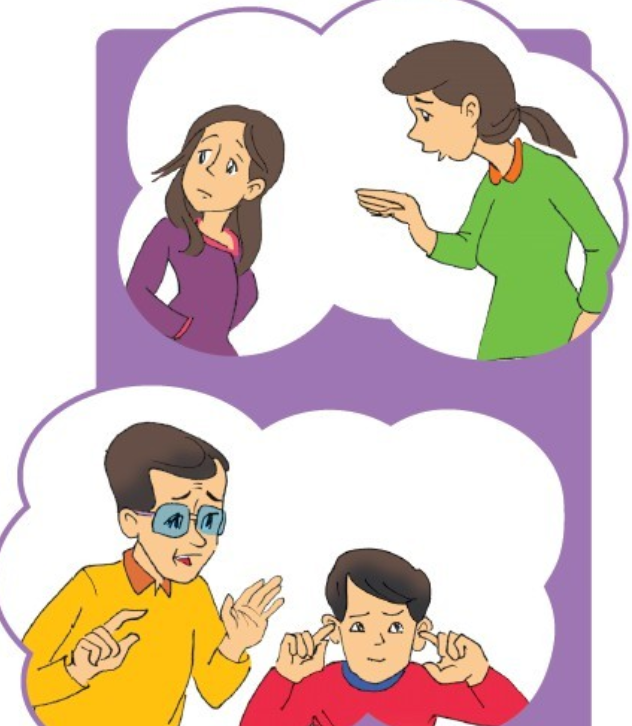Bài học cùng chủ đề
Báo cáo học liệu
Mua học liệu
Mua học liệu:
-
Số dư ví của bạn: 0 coin - 0 Xu
-
Nếu mua học liệu này bạn sẽ bị trừ: 2 coin\Xu
Để nhận Coin\Xu, bạn có thể:

Luyện tập SVIP

After language lessons, we are going to read a text about the conflicts between parents and their teenage children. After reading we can answer the question Where do conflicts come from? and elicit reading strategies.


Ready, steady, go!

Where do conflicts come from?
Throughout history, there have always been conflicts between parents and their teenage children. Here are some of the main reasons and explanations.
No matter how old their teenage children are, most parents still treat them like small kids. As they try to help their children to discover the surrounding world, parents strongly believe they know what is best for their children. However, as children grow up, they want to be more independent, create their own opinions, and make their own decisions. They don't feel comfortable when their parents still keep treating them like little kids.
One common area of conflict is the clothes children want to wear. Parents may think that these clothes break rules and norms of society, or distract them from schoolwork. What is more, some teens want expensive brand name clothes, which can lead to a financial burden on their parents because many cannot afford the high prices.
Another source of conflict is the way children spend their free time. Parents may think that their children should spend their time in a more useful way rather than playing computer games or chatting online. But children do not always see things the way their parents do.
Conflicts also arise from different interests between parents and their children. Some parents may try to impose their choices of university or career on their children regardless of their children's preferences. Actually, the list of conflicts seems to be endless. Open communication can really help to create mutual trust and understanding between parents and their teenage children.

Where do conflicts come from?
Throughout history, there have always been conflicts between parents and their teenage children. Here are some of the main reasons and explanations.
No matter how old their teenage children are, most parents still treat them like small kids. As they try to help their children to discover the surrounding world, parents strongly believe they know what is best for their children. However, as children grow up, they want to be more independent, create their own opinions, and make their own decisions. They don't feel comfortable when their parents still keep treating them like little kids.
One common area of conflict is the clothes children want to wear. Parents may think that these clothes break rules and norms of society, or distract them from schoolwork. What is more, some teens want expensive brand name clothes, which can lead to a financial burden on their parents because many cannot afford the high prices.
Another source of conflict is the way children spend their free time. Parents may think that their children should spend their time in a more useful way rather than playing computer games or chatting online. But children do not always see things the way their parents do.
Conflicts also arise from different interests between parents and their children. Some parents may try to impose their choices of university or career on their children regardless of their children's preferences. Actually, the list of conflicts seems to be endless. Open communication can really help to create mutual trust and understanding between parents and their teenage children.
Read the text quickly and click which of the following are found in the text.

a. parents and children having different tastes in music
b. parents' strong opinions about everything related to their children
c. children's objection to the way their parents treat them like small kids
d. parents' objection to their children's clothes
e. parents' expectations of their children's better use of free time
f. parents' strong views about their children's education and future jobs
g. parents and children having different beliefs
Match the hightlighted words in the text with the definitions.

Where do conflicts come from?
Throughout history, there have always been conflicts between parents and their teenage children. Here are some of the main reasons and explanations.
No matter how old their teenage children are, most parents still treat them like small kids. As they try to help their children to discover the surrounding world, parents strongly believe they know what is best for their children. However, as children grow up, they want to be more independent, create their own opinions, and make their own decisions. They don't feel comfortable when their parents still keep treating them like little kids.
One common area of conflict is the clothes children want to wear. Parents may think that these clothes break rules and norms of society, or distract them from schoolwork. What is more, some teens want expensive brand name clothes, which can lead to a financial burden on their parents because many cannot afford the high prices.
Another source of conflict is the way children spend their free time. Parents may think that their children should spend their time in a more useful way rather than playing computer games or chatting online. But children do not always see things the way their parents do.
Conflicts also arise from different interests between parents and their children. Some parents may try to impose their choices of university or career on their children regardless of their children's preferences. Actually, the list of conflicts seems to be endless. Open communication can really help to create mutual trust and understanding between parents and their teenage children.
Read the text carefully. Answer the following questions.

1. How many main reasons of conflicts between parents and their teenage children are mentioned?
A. 3 B. 4 C. 5
2. Why do most parents still treat their teenage children like small kids?
A. Because they strongly believe they know what is best for their children.
B. Because their children spend most of the time playing computer games or chatting online.
C. Because they try to help their children to discover the surrounding world.
3. What do children want to be and do as they grow up?
A. They want to be more independent, create their own opinions, and make their own decisions.
B. They want to wear expensive brand name clothes they get mad.
C. They want to chat online and play computer games all day.

Where do conflicts come from?
Throughout history, there have always been conflicts between parents and their teenage children. Here are some of the main reasons and explanations.
No matter how old their teenage children are, most parents still treat them like small kids. As they try to help their children to discover the surrounding world, parents strongly believe they know what is best for their children. However, as children grow up, they want to be more independent, create their own opinions, and make their own decisions. They don't feel comfortable when their parents still keep treating them like little kids.
One common area of conflict is the clothes children want to wear. Parents may think that these clothes break rules and norms of society, or distract them from schoolwork. What is more, some teens want expensive brand name clothes, which can lead to a financial burden on their parents because many cannot afford the high prices.
Another source of conflict is the way children spend their free time. Parents may think that their children should spend their time in a more useful way rather than playing computer games or chatting online. But children do not always see things the way their parents do.
Conflicts also arise from different interests between parents and their children. Some parents may try to impose their choices of university or career on their children regardless of their children's preferences. Actually, the list of conflicts seems to be endless. Open communication can really help to create mutual trust and understanding between parents and their teenage children.
Read the text carefully. Answer the following questions.

4. Why are parents concerned about the clothes their teenage children want to wear?
A. They are worried because these clothes may break rules and norms of society, or distract them from schoolwork.
B. They are worried because these clothes may lead to a financial burden on them.
C. They are worried because these clothes are too expensive for them to afford.
5. How do parents want their children to spend their free time?
A. They want their children to spend their time sharing the household with them.
B. They want their children to spend their time in a more useful way.
C. They want their children to spend their time doing some voluntary work at the local hospital.

|
Always look at the text first before you look at the questions to have a general idea what it's about. Read the questions and underline key words from the questions. Scan the text for key words and synonyms of key words from the questions. Read the sentences around the key words to get the information needed. |
Luôn luôn nhìn vào văn bản trước khi đọc câu hỏi để nắm được nội dung cơ bản của văn bản. Đọc câu hỏi và gạch chân các từ khóa trong câu hỏi. Scan văn bản tìm từ khóa và các từ đồng nghĩa với từ khóa trong các câu hỏi. Đọc các câu xung quanh từ khóa để thu thập thông tin cần thiết. |
Các bạn nên tìm đọc thêm về phương pháp SKIM & SCAN để nâng cao kĩ năng đọc của mình nhé!
Answer the following question.
Do you get into conflict with your parents?
Có bốn nguyên nhân chính dẫn đến những mâu thuẫn giữa bố mẹ và con cái.
1. Càng lớn con cái càng muốn độc lập nhưng bố mẹ luôn coi chúng như những đứa trẻ.
2. Bố mẹ nghĩ quần áo mà con mình mặc phá vỡ mọi quy tắc và chuẩn mực xã hội. Đôi khi chúng muốn diện quần áo có thương hiệu đắt tiền gây gánh nặng kinh tế với bố mẹ.
3. Bố mẹ cho rằng con cái sử dụng thời gian rảnh rỗi không hiệu quả.
4. Do sự khác biệt trong sở thích, nguyện vọng nên bố mẹ thường áp đặt tư tưởng của mình lên con cái.
Chỉ có sự giao tiếp cởi mở chân thành giữa bố mẹ và con cái mới giúp họ hiểu và tin tưởng lẫn nhau.

Where do conflicts come from?
Throughout history, there have always been conflicts between parents and their teenage children. Here are some of the main reasons and explanations.
No matter how old their teenage children are, most parents still treat them like small kids. As they try to help their children to discover the surrounding world, parents strongly believe they know what is best for their children. However, as children grow up, they want to be more independent, create their own opinions, and make their own decisions. They don't feel comfortable when their parents still keep treating them like little kids.
One common area of conflict is the clothes children want to wear. Parents may think that these clothes break rules and norms of society, or distract them from schoolwork. What is more, some teens want expensive brand name clothes, which can lead to a financial burden on their parents because many cannot afford the high prices.
Another source of conflict is the way children spend their free time. Parents may think that their children should spend their time in a more useful way rather than playing computer games or chatting online. But children do not always see things the way their parents do.
Conflicts also arise from different interests between parents and their children. Some parents may try to impose their choices of university or career on their children regardless of their children's preferences. Actually, the list of conflicts seems to be endless. Open communication can really help to create mutual trust and understanding between parents and their teenage children.

Bạn có thể đăng câu hỏi về bài học này ở đây
